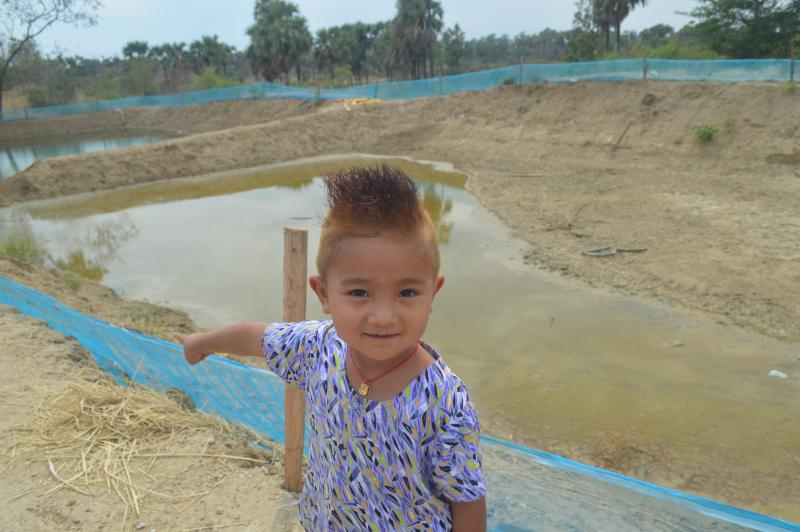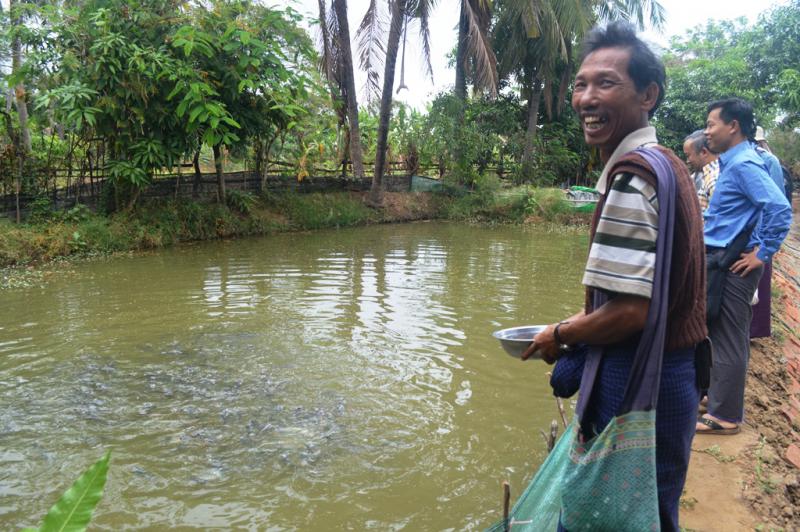
People in Myanmar’s Dry Zone are improving their nutrition and incomes by farming fish thanks to a project that trains communities on how to set up sustainable small-scale aquaculture using simple technology.
Water is scarce in central Myanmar’s dry zone and fresh fish is not always available. Demand for fish is largely met by importing it from other parts of the country. At donation ceremonies people treat their guests with dried fish for the main course as fresh fish can be difficult to obtain in large quantities.
So, although people like fish they are more accustomed to eating locally-available meat and may be missing out on the vitamins and minerals provided by fresh fish – a healthy source of protein.
According to international studies, fish is one of the healthiest foods and is one of the most important sources of quality animal protein. A 2016 report FAO states that global per capita fish consumption has risen to more than 20 kilograms a year.
A project funded by the Livelihoods and Food Security Trust Fund (LIFT) in Meiktila and Yinmabin towships in the Dry Zone is working to improve communities’ access to fresh fish. The three-year MYCulture project is implemented by WorldFish, in partnership with the Department of Fisheries, GRET, NAG, and Pact. The project aims to stimulate the sustainable growth of small-scale aquaculture that increases incomes for small-scale producers and improves the food and nutrition security of households in the central Dry Zone of Myanmar as well as in the Ayeyarwady Delta.
The project supports producers with production inputs such as fish seeds, training and innovative technology that is adapted to local conditions. The training focuses on disseminating knowledge about small scale aquaculture and nutrition.

Ma San May and her husband U Chit Khaing are looking forward to the income they will earn next week when they sell the fish from their pond. “The small scale aquaculture system was very new to us when it was introduced last year by the project. But we decided to work on this fish farming because we have extra land and no major problems accessing a water source. The project staff helped us a lot to manage the fish and pond. For us this is much more profitable than pig breeding,” U Chit Khaing said.
He explained that people whose houses had a lot of kitchen waste or could collect it easily from neighbouring houses, had enough resources to feed pigs and pig breeding could be a good a way to earn money for them. However, he said a household like his did not have enough waste and needed to buy pig feed supplies, making pig breeding less profitable. “Fish farming is a better business for us,” he said.
He explained that it cost MMK 100,000 to buy two piglets. If fed properly they could be sold for around MMK 400,000 MMK for each pig. If pig feed has to be bought from an outside supplier, the additional expense for about 240 viss (around 385 kg) of pig feed, which is approximately what is required for a pig to reach its optimal growth, would cost around MMK 1,200,000. So there would be no profit for a farmer like him who could even end up making a loss of around MMK 500,000. But fish farming is different. U Chit Khaing said that with his vacant backyard that can be used for a fish pond and an accessible water supply he needs to spend He only needs to spend on buying fingerlings at MMK 60 and 1,000 fishes require about five bags of fish feed for about MMK 120,000 for his fish to reach a marketable size. The feed is easily available through local suppliers. So his total estimated earnings will be around MMK 1,000,000 for about 300 viss of fish and after his expenses his profit is around MMK 800,000.
“This is an extra income source for us and we don’t need to spend much time for this work - twice a day to feed the fish - but that is also a relaxing time for us; a quick break time from our daily farm work nearby. We often chat with other farmers in the village and show off about our fish survival and growth”, U Chit Khaing’s wife Ma San May says proudly.
The project trains small-scale aquaculture farmers on the fish farming technology as well as on the nutrition benefits of eating fish.
“After attending the training of how to raise fish properly, I realise why consumers did not like my fish before”, said fish farmer Daw San San Lwin from Pauk Pin Aint Village, in Meiktila Township. “Back then I thought fish could grow wherever there is water. So I just put fishes in my pond and did not give any special care so that fishes did not grow well at their optimal potential.” At that time her fish did not get a good market price because people complained that the fish were bony and had less flesh. After attending the training, she learned a lot about proper fish feeding and how to keep the pond clean enough to contribute to fish growth. “It is such a complete difference now. Before I put the Water Hyacinth in the pond as I thought that this plant will cool down the water temperature supposing that fresh water is good for fish. After I attended the training, I learned that it’s not recommended to do this as water hyacinth grows very fast and that disturbs the fishes’ movements in the small pond and hinders the fish growth. Now I also know how and when to feed fish so my fishes are healthy. People say my fish are so delicious to eat”, Daw San San said with a big smile. She has linked up with regular buyers for her fish and they sell them back at the market. “This is such a win-win situation. People also get the fresh fish and the earnings helps me to settle my family expenses,” she said.
The initiative of small scale aquaculture project (SSA) has now lightened up to partly fulfill the demand of fish supply in the central dry zone and the hopes of people to be able to eat a variety of fresh fish locally available.



